Final report for OS23-170
Project Information
One simple solution: Adding fish to rice fields.
Fish add an additional income stream to acreage used to grow rice in the summer, creating year-round productivity and a new revenue source from virtually the same amount of land and water. And, when young fish are introduced, initial research has indicated they have the potential to reduce methane emissions by up to two-thirds.
FIF’s original controlled study was conducted on California rice farm sites from 2012-2018. Collaborating with farmers, University of Montana aquatic ecologist, Dr. Shawn Devlin, scientists from UC Davis and the California Department of Fish and Wildlife (CDFW), controlled experiments were performed comparing paddies with fish to those without fish. In 2018, FIF demonstrated that ponds with fish emitted 65% less methane than ponds without fish. This striking methane reduction is the result of a trophic cascade, a process that occurs when fish alter the microscopic food chain of the nutrient-dense flooded rice fields.
Aligning with SARE’s grant program focus areas, 2 and 7, FIF creates affordable, effective incentives for farmers to adopt conservation and stewardship practices. FIF introduces fish into winter-flooded rice fields as a seasonal second food product, which serves as both a market-driven economic incentive and a multi-benefit conservation practice for working landscapes. To date, we have found:
- Initial data has found that rice fields are 10x more productive for raising fish than wild systems,
- Unlike commercial aquaculture practices, FIF requires no additional expensive fish feed.
- The addition of small fish to fallow, flooded rice fields may significantly reduce methane emissions associated with winter
- Seasonally flooded landscapes support biodiversity, wetland habitat connectivity via migratory flyways and fish passages
- FIF integrates easily into existing rice systems where winter flooded fields enable bird habitat and waterfowl hunting, producing a second annual crop without additional land/water usage.
In October 2022, research on the FIF system was expanded to Arkansas – the largest rice producing state in the United States. The research is ideally sited at Isbell Farms, where Dr. Benjamin Runkle and his University of Arkansas Landscape Flux research group has spent the last eight years studying the connections between carbon and water cycles in agricultural and wetland environments (Moreno-García et al., 2021; Runkle et al., 2021, 2019, 2017; Karki et al., 2023, accepted and forthcoming). The FIF project benefits from the University of Arkansas group’s depth of knowledge and expertise, their existing infrastructure of research plots, as well as the use of their highly sophisticated GHG-measuring flux towers. In addition, the entire project is made possible through a generous in-kind donation from the Isbell family, who have provided 140 acres of land, water and farm equipment, supplies and expertise.
Our long-term vision is that Agriculture must sustainably adapt to an era of climate change to continue to feed the world, and FIF can play a role in stimulating this transition. The global food system accelerates climate change, which in turn disrupts traditional weather patterns and affects global agriculture, politics and hunger. Since roughly one-third of human-caused greenhouse gas emissions come from agriculture, Fish in the Fields can affect policy change from a systems approach based on science, natural resource management and public-private partnership. FIF’s methane reduction strategy harnesses ecological principles to ensure long-term productivity of rice growers and the rice/wetland ecosystem year round, which in turn supports increased water conservation, species diversity, and wildlife habitat.
Funding in this SARE project will enable activities in three main areas:
- Synthesize research findings from the ongoing pilot project, which supports great measurements by latching onto ongoing measurement campaigns, but lacks support to provide synthesis of findings. In particular, this project will allow a clearer contrast between adjacent fish-amended and control (no-fish) fields, based on comparison of a broader suite of agronomic, environmental, and production data.
- Education and outreach. The project team will develop and deliver educational materials for presentation in annual Field Day Events, hosted on-site in Arkansas to a wide audience of farmers (rice producers, fish farmers), extension and research scientists, and supply chain partners.
- Feedback on project aims. We anticipate that the Field Days will enable ample time for structured interactions and discussions with participants to assess how the FIF concept can be extended beyond the test farm. The participants will provide feedback on ways to improve the FIF concept, rigorously question stated outcomes, and be involved in the design of a new vision for integrated fish-rice production in Arkansas.
Fish in the Fields (FIF) is seeking answers to the question of how fish can be used to reduce methane emissions from rice. All necessary conditions are present for the replication of prior research protocols and results in California. We believe that applying Dr. Devlin’s research to Arkansas’s rice fields via FIF will provide the scientific basis for expanding rice-fish farming systems across rice acreage worldwide, which will in turn, strengthen FIF’s work to its initial goals of sustainable agricultural innovation, water conservation, migratory waterfowl habitat preservation, and social enterprise. RRI’s years of preliminary work have allowed FIF to establish the parameters for experimentation ( e.g., fish species and size, plankton abundance and diversity, water quality and source, field design) and expand the scope of work to include carbon cycling in existing FIF rice-fish farming system. Understanding why and how fish can be used to reduce methane burden.
How Fish in the Fields works.
In the Spring, rice fields are flooded and prepared for the 120-day rice growing season. After rice is harvested in the fall, the straw residue is either burned or incorporated and the fields are reflooded to decompose the remaining rice straw and provide waterfowl habitat. This is where Fish in the Fields comes in. We plant fish in winter flooded fields, where they grow rapidly on naturally abundant plankton until they are harvested in March, when the cycle repeats. FIF’s strikingly simple, replicable design is possible because of the favorable qualities of the minnow species–robust growth, tolerance of temperature fluctuation, prolific reproduction and a diet of zooplankton. No additional food, water or land are needed.
During our research period, FIF’s convergence of test sites, farm partnerships, hatcheries and team of advisors provided a perfect opportunity to study and test how the addition of fish affects rice field productivity and methane emissions in California rice fields. The results were positive and encouraging. Rice fields proved to be ten times more productive in growing fish than wild systems, and the addition of fish reduced the methane emissions from rice production - dramatically - by as much as 65%. Our test ponds also served as a site for the development of many innovations in pond and hatchery design and harvest methods, as well as the discovery of relevant academic research, all of which refined and improved the FIF model (hereafter referred to as the “FIF Winter Protocol”).
Arkansas FIF 3 year Pilot
The FIF Arkansas demonstration project (est. 2022) is a partnership involving Key Project Cooperators to assess the feasibility of FIF practices in Arkansas. Launched in mid-October, 2022, FIF is a landscape-scale pilot project to research and quantify how the addition of fish to fallow flooded rice fields impacts fish growth, and how it affects the methane emissions associated with winter flooding of rice fields.
Site, Scope and Capabilities:
The 3-year, 140-acre (one 70-acre test plot and one 70-acre control plot) study will be hosted by Zero Grade Farms, an Isbell Family Partnership in England, AR, in the heart of the Southeastern rice-growing region. A leader in innovative, sustainable rice-growing practices, Isbell Farms is already the site of a multi-year University of Arkansas greenhouse gas study that will provide the FIF research team with existing infrastructure and sophisticated measurement tools. Among them are two eddy covariance towers that furnish greenhouse gas emissions data around the clock, including methane and carbon dioxide. Additional site measurements include nitrous oxide dynamics via the closed chamber technique.
Primary Research Objectives :
- Measure the efflux of GHGs in fish-present and fish-absent winter-flooded in comparable and adjacent 70-acre field plots.
- Produce data on dissolved oxygen, zooplankton abundance, bird predation and fish mortality associated with the preferred FIF stocking density (100 lbs/acre) of golden shiners.
- Quantify total production (lbs. in/lbs. out) of fish biomass for juvenile golden shiners in winter-flooded rice paddies in central Arkansas.
- Conduct initial fish growth modelling for juvenile golden shiners in winter-flooded rice paddies in central Arkansas.
- Calculate the amount of methane present in flooded rice paddies that is converted into fish biomass via the process of “trophic shunting”.
- Conduct initial studies into how the introduction of fish helps rice fields cycle and retain nutrients.
- Develop areas for further research.
Project activities will follow in the collection of this set of research activities, synthesis and discussion among project participants, and the development of tractable educational materials for presentation and communication at the funded Field Days.
Cooperators
- - Producer
- (Researcher)
- - Producer
- (Researcher)
- (Educator and Researcher)
- (Researcher)
Research
Overall, the Fish in the Fields pilot project is based on a three-year plan, with this final SSARE grant report overlapping with Years One through Three of the fish growing seasons and related data collection. Although scientific analysis necessarily lags behind the fish growing experimental period, on the ground experience is occurring in real time and is used to inform and refine our processes year over year. Therefore, this section includes key learning from our three growing seasons that provide the basis for modifications in the future.
As described in our proposal, the 3-year, 140-acre (one 70-acre test plot and one 70-acre control plot) study is hosted by Zero Grade Farms, an Isbell Family Partnership in England, AR, in the heart of the Southeastern rice-growing region. For the past 8 years, the site has served as a multi-year University of Arkansas greenhouse gas study that also provides the FIF research team with existing infrastructure and sophisticated measurement tools. Among them are two eddy covariance towers that furnish greenhouse gas emissions data around the clock, including methane, nitrous dioxide, and carbon dioxide.
Year One: introduction and trial period, adjusting for local weather and climate; data gathering and analysis
Year One launched in October, 2022, with the delivery of 7,000 pounds of golden shiners from I.F. Anderson Minnow Farm. Over the winter months, fish were monitored and water samples were collected by Dr. Dayan Perera’s team from University of Arkansas, Pine Bluff, Aquaculture Extension and Fisheries. Dr. Ben Runkle and Dr. Michele Reba and their team were concurrently monitoring greenhouse gas emissions via the eddy covariance towers at the project site. The fish were harvested in late February with the support of the Isbells and a crew from I.F. Anderson Minnow Farm. The FIF model calls for slow, controlled drainage that gradually concentrates the fish in accessible channels where crowding and seining takes place. Unfortunately, due to continuous rain and flooded conditions in the region, water levels in our rice fields remained persistently high. The majority of the fish remained dispersed in high water, reducing the fish harvest significantly. Clearly, this first harvest was an important learning experience for everyone involved, all of whom were new to the process. Our Year Two process reflected that learning, resulting in a smooth and efficient harvest.
Year Two: refinement and streamlining of stocking and harvest process, data gathering and analysis from Year One, growing stakeholder engagement
In mid-November 2023, we launched Year Two of our Arkansas pilot. As we anticipated, the takeaways from our first season provided the groundwork for this year’s experimentation. Consistent with Year one, we conducted our research on the same two adjacent 70-acre flooded fields, one stocked with fish and the other a fish-free pond used as a control. Once again, over the winter months, fish were monitored and water samples were collected. At the same time, Dr. Ben Runkle and Dr. Michele Reba and their team concurrently monitor greenhouse gas emissions via the eddy covariance towers at the project site. The fish were harvested in March with the support of the Isbells and a crew from I.F. Anderson Minnows.
Year Two methods revised based on Year One learning:
- Prior to field flooding, 1) cleared vegetation in edge-of-field channels to improve access for crowding/seining fish, 2) added inflow irrigation screens, and strengthened outflow screens to prevent fish escapements.
- Increased initial rice field water levels prior to fish stocking (compared with Year One) to promote fish survival.
- Reduced fish stocking rate by half (from Year One) to 3,500 pounds to test the impact of less fish on methane efflux and aim to reduce mortality/escape rates from Year One.
- Stocked fish on 11/16/23 (later date than Year One) based on a collaborative decision of all stakeholders that took into account multiple factors including farming schedules, fish delivery timing and cooler temperatures (that are less stressful for fish).
- A new aquatic ecologist, Dr Alan E. Wilson, Auburn University joined the team, revised prior year water quality and nutrient sampling protocols and provided graduate students with training on sampling and storage procedures.
- Closely monitored water levels to optimize conditions for fish harvesting.
- Purchased and employed transformative new vacuum pump fish harvesting equipment - Fish pump Pescamotion 10 (2,5” - Ø60 mm), manufactured by FAIVRE, France - to improve harvesting effectiveness and efficiency.
- Harvested fish on 3/11/24 (later date than Year One) to take advantage of clear weather to allow for better control of water levels.
Year Three: replicable and scalable plans for stakeholders and adopters
As we did with Year One, we assessed Year Two and considered further ways to optimize and improve FIF operations, beginning with field preparations in Fall 2024. We stocked fish on Nov. 15, 2024 at a density in between the previous two years (i.e., 2381 kg or 5250 lbs). We also supplemented our gas flux measurement plan with the closed chamber technique through complementary funding from the Natural Resources Conservation Service (NRCS) via a Conservation Innovation Grant (CIG). These fish were then harvested on March 14, 2025, where we also held a field day. That day included some highlights:
- 40 people in attendance across a variety of sectors (NGO, Academic, Private, Gov't, Trade Assoc, Philanthropy)
- Presentation and distribution of the new Fish in the Fields™ Program Implementation Guide (First Edition, March 2025)--see attached.
- Presentation and distribution of the mock-up packaging design for our new cobranded minnow-based pet treat for cats and dogs, Lucky Catch.
- Field trips to eddy covariance flux towers and chamber plots with presentations from students from the University of Arkansas.
- 1,500 lbs of fish harvested (water level management and escapement due to screening at outflow and field design remain challenges.)
- Successful use of fish pump technology for the second time, with new water sorting hopper attachment.
- Film interviews with USA Rice, Anderson Minnows, and the Isbell family.
- Delivery of our new (initial) fish processing facility co-located with the workshop and storage area.
Results from Years One through Three:
- Initial analysis of Year One methane emissions data yielded positive impressions: Comparing the 2022-23 season with other seasons (2015-2023), and the field with fish to the neighboring control field without fish, the results look promising. They suggest that the addition of fish may have had the positive effect of decreasing methane emissions during the flooded period when fish were present at the site. More work is necessary before these changes can be attributed to the presence of fish. In the following years (2023-24; 2024-25), we saw very low methane emission rates, indicating that in either case - flooded with or without fish - the fields are not substantial sources of methane to the atmosphere. This finding has implications beyond this project - e.g. when considering the possible implications of fallow-season flooding for the production of waterfowl habitat. These results are being written up for publication in a manuscript led by Sam Carroll, a MS student funded in part through this project.
- In Year Three, additional sampling via the closed chamber method in a related project from the NRCS indicated fairly low methane and nitrous oxide emissions from the fields; this data will be analyzed in concert with data from other seasons to provide year-round perspective on the potential impact of field flooding and fish production on greenhouse gas emissions.
- In each project year, we observed positive fish growth and fish health (little evidence of Saprolegniosis fungal disease that may afflict fish in Arkansas in cold weather). For Year Two, mass average calculations conducted at time of 2024 harvest suggest an average fish biomass growth (g) rate of 269%.
- Fish samples were sent to Dr. Perrera’s lab at University of Arkansas, Pine Bluff for proximate analysis to estimate the quantitative food substance including moisture, crude protein, total fat, total carbohydrate, and dietary fiber, and to test for the presence of disease.
- Fish samples sent were to KPrime Labs in California for heavy metals testing.
- Water samples including zooplankton abundance, total nutrients, dissolved nutrients, and algal biomass taken from experimental and control rice fields were sent for analysis to Dr. Alan Wilson, Auburn University.
- In Year Two, the use of newly purchased mechanized harvesting equipment vastly improved the efficiency and effectiveness of fish harvesting over manual seining methods used in Year One. 2,600 pounds/1.5 tons of fish were harvested in under 40 minutes. We estimate 500-1,000 pounds of fish remained in the field at the conclusion of harvest demonstration.
Educational & Outreach Activities
Participation Summary:
We had a diversity of presentations and outreach activities, as follows:
- 7/28/2023: Jeremy Jones’s Presentation at USA Rice & Ducks Unlimited’s Third Rice Stewardship Partnership Summit in Little Rock, Approx. 40 in attendance representing producers, conservationists, academics, project implementers, etc. Arkansas. Agenda and media footage: RSP Summit III Agenda-Final (1)
- 11/16/2023: On-farm field day (Year 2 launch event) with USDA representatives, Isbell Farms, and I.F. Anderson Farms. Example Media:
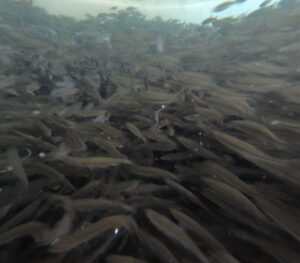
Fish installation - many darters underwater for the release in November, 2023 (photo Chance Cutrano) 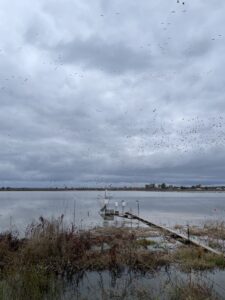
The eddy covariance measurement station and waterbirds at Isbell Farm, Nov 2023 - 1/29/2024: Graduate student Sam Carroll’s poster at 26th Annual Arkansas Soil and Water Conference and Irrigation Expo (ASWEC) in Jonesboro, Arkansas. Awarded first place M.S. poster (See title and abstract below). Ongoing research to be written for an MS thesis in Biological & Agricultural Engineering, University of Arkansas. Spoke to approx. 20 conference participants, awarded in front of approx. 150 conference participants.
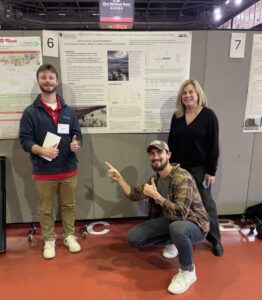
Graduate student Sam Carroll with Project partners Chance Cutrano and Deb Moskowitz, in front of poster at ASWEC conference. - 2/29/2024: Field Trip to Isbell Farms and Fish in the Fields project site visit during the 4th Annual American Craft Sake Fest with representatives of the rice farming, rice milling, and sake brewing industries. Agenda: Agenda — American Craft Sake Fest
- 3/11/2024: On-farm field day (Year 2 harvest event) with Isbell Farms and I.F. Anderson Farms. Media footage:
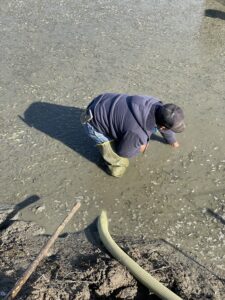
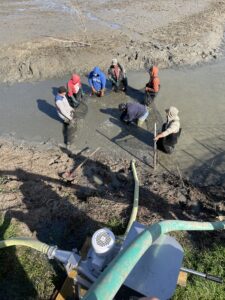
- Discussions with different farmers at ASWEC, Rice and Cotton conference (Jonesoboro, AR, 1/30-1/31/24)
- Discussions with different farmers at ASWEC, Rice and Cotton conference (Jonesoboro, AR, 1/29/25)
- Discussions at Rice Technical Working Group meeting (including oral presentation), New Orleans, LA, 2/18/25
- Field day at Isbell Farm associated with fish harvest, Lonoke County, AR, 3/14/25, covered by USA Rice in their daily newsletter here:
-
Other press about the project generally can be found here:
Forbes: https://www.forbes.com/sites/jeffkart/2023/12/27/fish-in-the-fields-cuts-methane-creates-revenue-for-rice-farmers/
The Fish Site: https://thefishsite.com/articles/fish-in-the-fields-wins-jmk-innovation-prizeNonprofit Quarterly: https://nonprofitquarterly.org/the-ancient-practice-that-boosts-sustainable-food-production/
Weather Channel: https://www.theweathernetwork.com/en/news/climate/solutions/adding-fish-to-rice-fields-helps-environment
11. Conference presentations:
Carroll, S. R., Mahbub, R. B., Moreno-Garcia, B., Reba, M. L., & Runkle, B. R. K. (2024, January). Effect of Fish Addition on Fallow Season CH4 Emissions in Arkansas Rice Fields. Arkansas Soil and Water Conference and Irrigation EXPO
Carroll, S., Mahbub, R. B., Moreno Garcia, B., Ranniku, R., Reba, M., Runkle, B. R., Arkansas Soil and Water Education Conference and Irrigation EXPO, "Fish Cultivation in Fallow Season Rice Fields: Effects on Landscape Methane Emissions," Arkansas State University, Jonesboro, AR, United States. (January 29, 2025).
Carroll, S., Moreno Garcia, B., Mahbub, R. B., Ranniku, R., Reba, M. L., Runkle, B. R., Rice Technical Working Group, "Fish Cultivation in Fallow Season Rice Fields: Effects on CH4 Emissions," New Orleans, LA, United States. (2025).
Poster abstract (2024):
Rice production contributes about 8% of global anthropogenic CH4 emissions. Currently, around 27.5% of Arkansas rice fields are flooded in the winter, which can increase CH4 emissions in the fallow season by 45% compared to non-flooded fields. Co-cultivation is a process whereby rice and aquatic animals are cultivated in the same field. Co-cultivation techniques can reduce CH4 emissions through trophic cascading and provide a second revenue stream to farmers along with the rice crop. This study uses a pair of fields in Lonoke County, Arkansas to quantify the effects of fish (golden shiners) on fallow season CH4 emissions with fish added to one field and the other left flooded with no fish. Gas flux measurements were taken using the eddy covariance method. Water samples were also taken to be analyzed for zooplankton abundance, algal biomass, total nutrients, and dissolved nutrients. After one season of data collection, the fish with field present had about 55% lower methane emissions (mean of 2.95 nmolm-2s-1) than the field with no fish (6.53 nmolm-2s-1). Difficulties such as gaps in the data, fish mortality, lack of replicates, and inconsistencies between the fields make it challenging to relate decreased CH4 readings to the presence of the fish. More years of data and further statistical analysis are needed to draw more definitive conclusions. Next steps for the project are gap filling and collecting and analyzing the next year of data.
Learning Outcomes
Valuable learning outcomes we will build on moving forward:
Weather considerations. While unpredictable weather is frequently an issue for agriculture, climate change brings even greater uncertainty, extremes and challenges for farmers. In our case, the Jan-March, 2023 period of our pilot study overlapped with 111 days of rain and flooding, the most in Arkansas since 1882. We had three major takeaways from this experience: 1) our Southeastern FIF template must develop guidelines for a wide range of weather and field conditions; 2) vacuum pump fish harvesting greatly improves the efficiency and productivity of fish harvesting compared with manual methods and may be especially helpful in less ideal harvesting conditions with deeper water, or when fish need to be harvested quickly from shallow water under drought conditions; 3) deep perimeter channels, like those at the Isbell Family's Zero Grade Farms, work well to contain fish and prevent fish escapement during rainy, windy and even flooded conditions.
Collaborating with agricultural leaders and forging strong relationships. A key to FIF’s successful launch and ability to meet on-the-ground challenges is the strength of our team of rice producers, rice and aquaculture trade association leaders, agricultural scientists and USDA/NRCS officers. FIF has brought together people with diverse specialities who have never worked together. Fortunately, FIF has become the beneficiary of this new synergy. During our recent harvest, for example, our rice grower and fish supplier combined their expertise to optimize water levels, accelerate and guide fish movement and ensure that golden shiner minnows remained healthy and robust during the 40-minute process that yielded over a ton of fish.
Building a business case: With the intensive workload, market variables and weather events that farmers live with every day, it isn’t surprising that they tend to resist change. History tells us that agricultural innovators must offer attractive incentives to spur farmer participation in new practices. FIF was conceived with this challenge in mind, and we have begun to build our business case with market research, nutritional and digestive testing, quantifying inputs and outputs, product development, market opportunities and financial projections.
Project Outcomes
Years 1 - 3 of the Arkansas pilot has yielded positive outcomes:
- Adoption of practice by Anderson Fish Farm and Isbell Family Farm
- New philanthropy to the Resource Renewal Institute (one prize, two foundation gifts, including a two-year gift - 2025, 2026)
- New federal grant to the project team, via NRCS CIG award "Fish in Fields: A Novel Climate Smart Practice for Reducing Methane Emissions from Rice Production," Sponsored by U.S. Department of Agriculture, Natural Resources Conservation Service, $100,000 (2024-2027)
- New collaboration: Dr Alan E. Wilson, Auburn University, joined the team on aquatic systems ecology
- We learned that the FIF model is compatible with normal Arkansas rice growing cycles
- Effective field design, including deeper perimeter channels, protect fish from freezing temperatures, predators and escapement.
- Indications of positive fish growth and fish health (little evidence of Saprolegniasis fungal disease that may afflict fish in Arkansas in cold weather)
- Collection of 3 years of valuable GHG data, water samples at significant intervals throughout the fish growing season, and fish samples pre-stocking and post-harvest.
- Market research showing 2 of the most promising uses for FIF fish are as an ingredient in pet food and as a source of feed for farmed salmon
- Engagement with farmers who are now involved and invested in the prototype fish product development
Our project team generated the attached pdf "Fish in the Fields program implementation guide" to support Arkansas producers in planning how to implement such a practice into their sustainability and production efforts: FISH IN THE FIELDS™ Program IMPLEMENTATION GUIDE